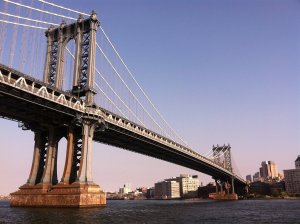
Through a recent UTC project, CAIT researchers were able to help NYCDOT engineers better understand the impact of dynamic amplification on the Manhattan Bridge. Photo ©NYCDOT.
Researchers are developing a new tool to monitor track misalignment on the Manhattan Bridge that will help NYC engineers make informed repair and rehabilitation decisions in the future. They are also investigating the impact of dynamic amplification on bridge-fatigue life and possible mitigation options.
Over 6,000 feet long, spanning the East River, and connecting the island of Manhattan to Brooklyn — the Manhattan Bridge is a signature and vital piece of infrastructure that carries approximately 1,000 trains and hundreds of thousands of passengers daily.
Historically, these railcars are full, with system wide ridership averaging 7 to 8 million that reduced to 2 million during the COVID-19 pandemic. It is anticipated that the “city that never sleeps” will bounce back just as it has from other major events in the past.
As a result of being exposed to repeated loads, especially those by trains running at full capacity, some portions of the bridge are beginning to show wear and tear. And, when bridge engineers noticed significant vibration whenever trains crossed over, they had questions about how these dynamic amplifications were impacting the infrastructure’s long-term service life.
Drs. Franklin Moon and Sougata Roy, faculty within the Department of Civil and Environmental Engineering and affiliated researchers at Rutgers CAIT, have been leading a team investigating these concerns and developing criteria to help owners make informed asset-management decisions through a CAIT-funded National University Transportation Center (UTC) project.
Recently, the team performed limited vibration tests at the Manhattan Approach, on each of the transit beams that support a set of rails. The goal of this study was to characterize the response of the bridge due to the misalignment of bolted rail joints, which introduced strong vibration as trains crossed them.
While these vibrations are not of imminent concern for the safety of the bridge, they do pose durability issues and can increase the maintenance cost if not intervened.
“Rails at joints always get hammered by crossing wheels and experience more wear,” Dr. Roy said. “The rail wear increases hammering. Repeated hammering loosens the bolted rail joints, increases stress fluctuations in the bolts, and the bolts fail in fatigue. With lost bolts the rails go more out of alignment — increasing vibration.”
A concept for monitoring the track with fiber optic sensors to alert engineers when these bolted rail joints are in need of repair was developed and implemented.
“We hope to detect and characterize misaligned bolted rail joints to provide NYCDOT with the information they need to cost-effectively implement repairs when needed,” Dr. Moon said. “This tool will provide bridge owners with a new and innovative approach for effective troubleshooting performance issues of signature bridges.”
There is real value in both the NYCDOT and MTA/NYCT understanding the impacts of train usage and planned service life on elevated crossings such as the Manhattan Bridge including an informed decision on possible transition from bolted to welded rail splices.
“Often times when people think about signature bridges they focus mainly on the signature spans,” Dr. Moon said. “It turns out that many of the problems these days are actually on the approach spans.”
To start, the researchers examined the bridge response using magnetically mounted accelerometers. The accelerometers were roved around to identify different levels of vibration associated with various bolted rail joints. Based on these results, they developed a criteria and organized the various rail joints into fair, poor, and severe, with severe being the most misaligned.
As expected, the more severely misaligned splices resulted in more vibration on the bridge, almost double that of the fair splices. This was further corroborated by the long-term stress measurements, which showed that more misaligned joints experienced higher stresses.

The Manhattan Bridge is a vital piece of infrastructure carrying thousands of trains and even more passengers daily. Photo ©Pexels.
“Fortunately, there are not a lot of severe splices at the sample location,” Dr. Moon said. “Also, higher vibration doesn’t necessarily have a more severe impact on the bridge over the long-term. While nothing we have seen suggests any safety concerns, the effect of vibration on the long-term durability of the bridge is more difficult to estimate. That research is where we are heading now with this project.”
The researchers are also mining the data to learn more about different variables such as service schedule, train weight, time of day, and other relevant parameters that might affect the bridge vibration. This is part of a bigger goal of understanding the impact of dynamic amplification on signature bridges and generating criteria for analyzing track misalignment.
“The immediate effect of this study will be to identify the susceptible joints and address fatigue failure of bolts such that the infrastructure remains safe for transit users and public spaces below,” Dr. Roy said.
“We are excited to see the results of this study and to help NYCDOT and its bridge engineers better understand the impact of these vibrations on the Manhattan Bridge,” Dr. Moon said.

